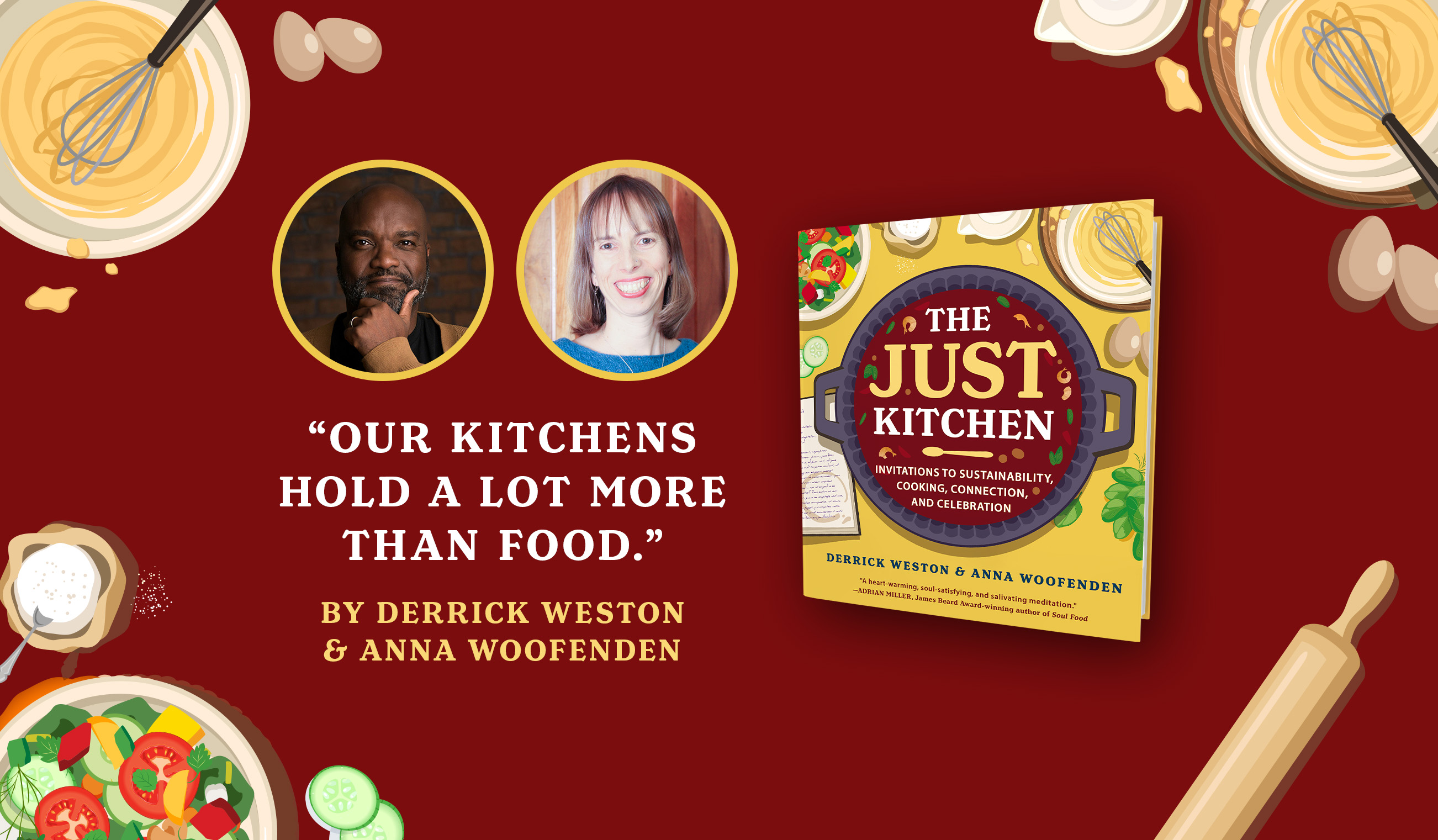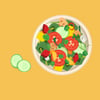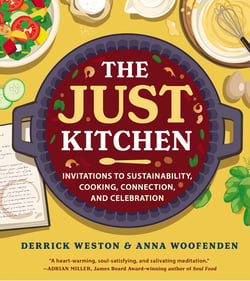There are a lot of books about food. Walk into your local bookstore, and you will find food histories, anthropological studies of food, scientific studies of what you should eat and why, and of course, any number of diet books and cookbooks. We—Derrick and Anna—have read a lot of these books. And as the cohosts (along with our friend Sam Chamelin) of The Food and Faith Podcast, we often get to speak with the chefs, writers, and activists who wrote them. But as we surveyed the landscape of what is written about food, we began to notice something missing.
There’s an important, growing number of books about the brokenness of the food system, particularly the extractive ways most of our food is produced. Other books focus on eating, usually highlighting the joys and benefits of slowing down and eating together in community. But what we only rarely saw were books focusing on where much of our time is actually spent: between food being produced and food being served, between the corn growing in the field and the grilled corn hitting the table. There’s just not much written about the kitchen and cooking itself, particularly from the lens of faith and justice. Oh, there are a lot of cookbooks, but there aren’t a lot of books about cooking.
What happens in our kitchens takes a significant amount of our time, resources, and energy. We want to talk about these things because, whether we recognize it or not, we put a lot of who we are and much of what we value into our cooking. And we believe that what happens in our kitchens matters.
We are not chefs. We are not food scholars. We are not culinary historians. We are two people who love talking about food and the spiritual connection to it, and we are two people who are committed to asking questions. During the run of The Food and Faith Podcast, we have asked our guests and ourselves questions you may have as well, such as:
- Where does the food we bring into our kitchens come from?
- Is it equitably accessed? If so, how? Could it be sourced more equitably?
- How does that food and how we prepare it help form community at the table?
What we discovered is that our kitchens hold a lot more than food.
My Evolving Kitchen: Anna’s Story
I was around eight years old, sitting on the threadbare couch in the living room of our partially finished, small wooden house in northwest Washington. Looking across toward the kitchen stove, I saw my mom standing there, stirring. One younger sibling was setting up wooden train tracks around the kitchen table legs. Another, just proficient at crawling, traversed the floor, often getting under my mom’s feet as she cooked. Occasionally, a pan lid clanked more loudly than necessary as a frustration and exhaustion I didn’t understand at the time boiled in my mother.
By the time dinner was on the table, her mood was often marked by weariness. The fact that most every night of my childhood there was a full and well-balanced, healthy, and often locally sourced meal on the table for our large family by 6:30 p.m. is not the texture of the memory (though it’s now something I deeply appreciate and honor). Instead, it’s the tired look in my mother’s eyes, my father’s attempt to make dinnertime conversation, and the sense that mealtimes were “supposed” to be something more joyful than they often were.
It wasn’t until I left home for college and started spending time in other kitchens that I could articulate and reflect on the tension I felt between whether the kitchen was a place of joy and warmth or a place of depletion and exhaustion. While living with a family in Colorado during an internship in college, I experienced the kitchen as a more consistently life-giving place. And in this case it wasn’t the mother of the family doing the cooking either. Dave is a fantastic cook, and it seemed to bring him joy to look through the fridge when he got home from work and start chopping and putting things together. I quickly found that the kitchen table was the place to be in this house, with two little kids running around, grown-ups chatting, and good food being made. My childhood assumptions about whose responsibility it was to feed the family were broken wide open: it turns out that the person who loves cooking and is good at it should be the one who cooks, rather than traditional gender roles dictating that. I began to reimagine what the kitchen could be in my life and the lives of others.
Food and Identity: Derrick’s Story
When you are young, food is food. It never would have crossed my mind as a kid to think of “Black” foods and “white” foods, but as I got older, and got to peek into more of my suburban white friends’ kitchens, it slowly dawned on me that what was happening in the kitchens of my youth was the preparation of Black food. Along with that realization came questions about the value of what was happening in my kitchen. Internalized racism asks, “If white people aren’t doing it, does that make it inferior?” Such questions didn’t linger, because what was coming out of the Black kitchens of my younger days was delicious! Though I ceased questioning the merit of the food itself, I was left with the observation that what was happening in our kitchen was a part of who we are, and that had value.
Over time, our family’s kitchen would become more “white.” Maybe a better way of saying that is that our kitchen became more middle-class American. More frozen things, more prepackaged things, more instant things. As time in the kitchen became more of a luxury for everyone in the house, convenience took precedence over culture. The casualty of this convenience was the loss of generational memory of what happens in Black kitchens. At some point, we lost sight of the kitchen as a place to preserve our culture. This, it seems, happens to a lot of us, regardless of race.
Though both my brother and I experimented and treasured our foods, our attempts to make fried chicken like our mom’s ended in grease fires. We wouldn’t have named it as such, but those failures were an attempt at keeping something of our past alive. I’m just now learning what to do with collard greens, thanks to the volumes on Black cooking. (I insist on growing them every year . . . for the ancestors.)
My early twenties were a blur of fast food. My late twenties and early thirties, though, were a time of slowly reintroducing myself to the kitchen space. I imagined myself a large-event chef, using as many pots and pans as possible to create elaborate meals (at least by my standards). That’s also when I began to love cooking shows. And let’s not forget the grill! I was thirty when I got my first grill. Grilling is an oddly gendered activity, an acceptable way to cook and still be manly. Though I’ve become suspicious of the gender dynamics that exist around cooking over fire, I still love grilling. And while the grill is outside, I consider it an extension of the kitchen.
Over the last decade, my cooking has been paired with an increased love of gardening, which has included an appreciation for African American contributions to the agriculture of this country. My interests now are around what cooking says about the people and cultures represented in the kitchen. I love shows like Chef’s Table and Ugly Delicious, and anything with the late Anthony Bourdain. Cooking has become for me a way of getting to know people, their history, and their values. This includes my own heritage. Some foods represent struggle and oppression. Others represent resilience and ingenuity. Still others represent celebration and victory. And you can have all of those experiences represented on one plate!
This is an excerpt from The Just Kitchen, chapter 1: “The Kitchen as a Keeper of Story and History.”




